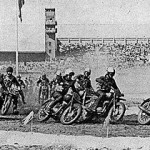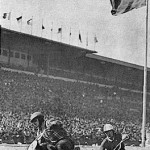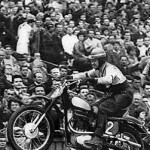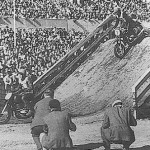The Great Victory Day Race
Dateline: Strahov Stadium. Prague, Czechoslovakia. May 9, 1956
As Americans, we’ve all been taught that the birth of supercross took place on a sandy, purpose-built track dropped between the 31-degree high banks of Daytona International Speedway on March 11, 1972. Just a few months later, a rock ‘n roll promoter named Mike Goodwin took the idea a huge step further when he brought motocross inside a football stadium in downtown Los Angeles and held a night-time race. Despite a few kinks, Goodwin’s funky new event was a rousing success and, for all intents and purposes, a sport was born.
37 years later, the sport of stadium motocross, or supercross, as we now it now, is one of the world’s premiere forms of motorsport (or PREMIERE form if you’re a 14 year-old American). On any given Saturday night from January through May, upwards of 60,000 fans fill up stick and ball stadiums across the nation to watch James Stewart, Chad Reed, Kevin Windham, Ryan Villopoto and many other Generation X superstars.
However, and truth be told, one of the first true stadium motocross races took place in the cavernous Strahov Stadium in Prague, Czechoslovakia on May 9, 1956. That day a 14 year-old named Jingrich “Harry” Gref sat in the sun high up in the grandstands with 80,000 other fans to watch the Great Victory Day Race (Great Victory Day marked the liberation of the Czechoslovakian Socialist Republic from Adolf Hitler’s brutal Nazi German reign by the Soviet Union).
“The first race was held in 1956 and it consisted of both speedway and motocross events,” Henry Gref, who now lives in Ohio, explained to this writer in 1998. “The outside section of the track was a big oval made up of a surface of cinders. Inside the oval was the motocross track, which was about half a mile in length and consisted of various obstacles, jumps, tight turns and a water crossing. There were seven to eight artificial jumps that were made out of wood with dirt and sand piled over them. And there was one major obstacle called “The Camel”. The jumps were so square and steep that it was not thinkable to consider double jumping them, especially with the equipment used at that point in time.”
At that time European-based motocross was still in its infancy stages (the Motocross des Nations of 1947 being the first true World Championship race), and the Great Victory Day Race was made up of riders exclusively from Czechoslovakia and a few other Eastern Bloc nations.
“Of course the race attracted all the best racers from Czechoslovakia, all of whom came from the factory CZ and Jawa teams or the major club teams,” continued Gref. “The CZ and Jawa factory teams were made up of riders that rode directly for the company. Just like today, the teams were very professional, but you have to remember that this was before CZ even had a presence in the World MX Championships.”
The first few Great Victory Day Races were each promoted from 1956 through the mid-1960s, in the years before the prestige of international Grand Prix motocross pushed the event to the backburner. In fact in 1957, a Swede named Bill Nilsson won the premiere 500cc World Championship and the sport of motocross immediately took hold of Europe.
The race was just so huge in our country!” declared Gref. “I don’t know the exact capacity of the stadium, but it was a huge place and there were at least 80,000 to 100,000 fans in the stands. I was so very impressed with the race that I got hooked on the sport. I was just dying to go out there and race. The stands were always packed and motocross was one of the biggest sports in the entire nation.”
In 2011, the Grand Prix of the Czech Republic will take place at the classic Loket circuit. When one really thinks about it, it just doesn’t seem real that 54 years ago men dressed in flannel shirts, leather pants and half-helmets were racing on an ersatz motocross track in a stadium before 80,000 fans. But believe it or not, they truly were.




